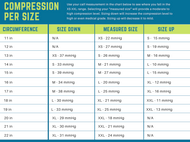The amount of compression a calf sleeve provides depends on three factors:
1. The amount of stretch in the fabric
2. The size of the sleeve, and
3. The circumference of the calf
When shopping for calf sleeves, you’re likely to see the compression level listed as a range. Our Trailblazer calf sleeves, for example, have a range of 10mmHg - 39mmHg. In terms of compression, the difference between 10 and 39 is quite significant. A person with a 14” calf who buys a size medium will get less compression than a person with a 15” calf. The size chart above will help you determine exactly how much compression each size provides for your calf measurement. Let’s take a look at what those compression levels mean.
Compression is measured in millimeters of mercury (mmHg) and divided into four categories:
- Mild (8mmHg - 15mmHg)
- Moderate (15mmHg - 20mmHg)
- High (20mmHg - 30 mmHg)
- Medical-grade (30 - 40 mmHg)
We used a calibrated Zwick machine to measure compression for a range of calf sizes. This process allowed us to refine our patterns for each size until we got them perfect. It also means we can tell you exactly how much compression each size will provide for your calf.
So which size is right for you?
First, determine the circumference of your calf. Use a soft tape measure around the widest part of your calf muscle, usually around 6in below your kneecap.
Next, use this measurement in the chart above to see where you fall in the XS-XXL range. To increase performance, reduce the risk of injury, and facilitate recovery, choose a moderate compression level (15mmHg - 20mmHg). If you need help with shin splints or knee instability, you may want to size down for a high level of compression (20mmHg - 30 mmHg). You can also size up for a mild level of compression (8mmHg - 15mmHg).
Learn more about the different levels of compression here.
If you have additional questions, please chat with a representative or give us a call during business hours at 866-830-5777


 British Pound
British Pound
